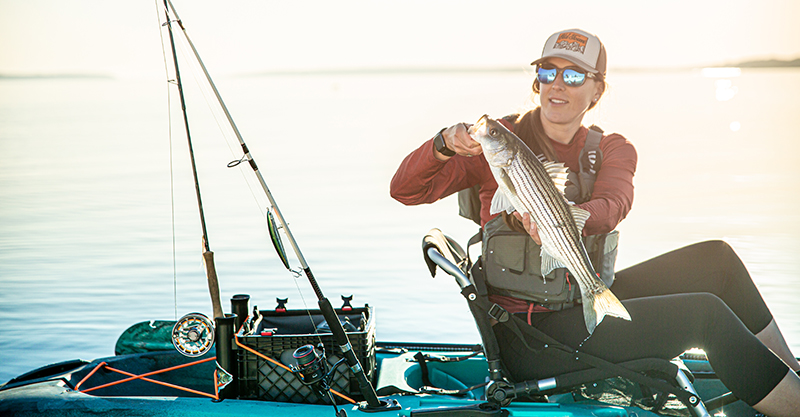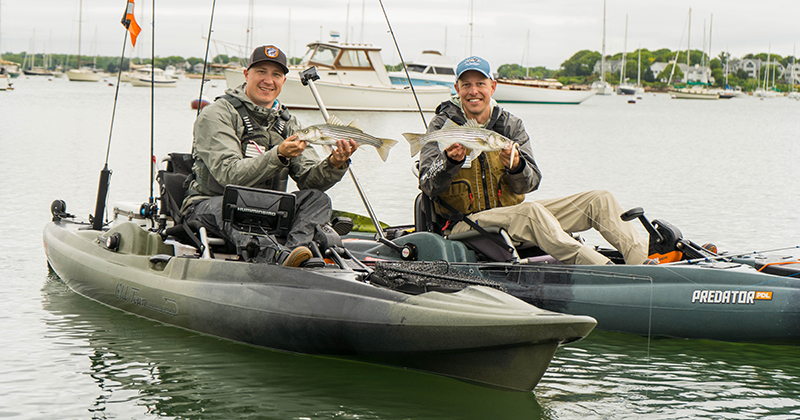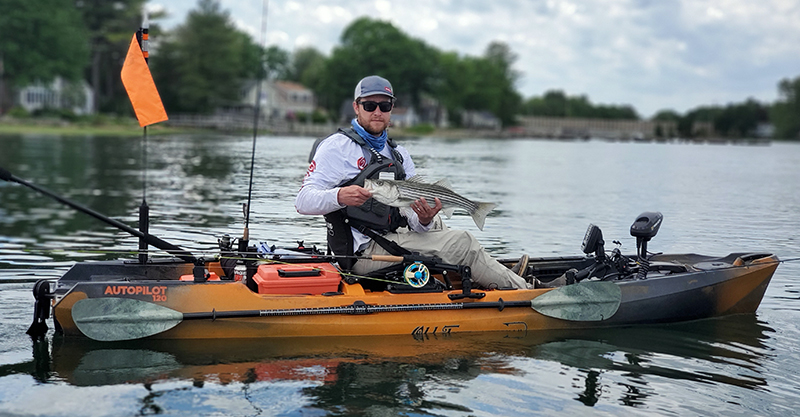Techniques For Striped Bass Kayak Fishing
By: Guyton Thorne
Ask a group of five kayak anglers what type of lure or setup is best for catching striped bass from the kayak, and you will likely get five different answers. Why? Some of it is a preference, but it is also because the striper fishery is very diverse, and they are a migratory species. How you fish for stripers in the spring or mid-summer, day or night, can vary significantly, as can techniques for different locations like inshore, river mouths, currents, rips, or offshore deeper waters.
In this article, I'll focus on a few techniques familiar to many of us who fish New England coastal waters:
- Topwater, Plugs, and plastics
- Live and chunk bait
- The ever-reliable tube and worm rig
- Fly fishing
TOPWATER STRIPER FISHING TECHNIQUES
Fishing topwater can be some of the most exciting fishing you will experience and is often the method of choice in the spring and fall when hungry stripers are making their migratory runs to and from their summer haunts. This time of year is when they will be feeding most aggressively, and feeds are easily visible due to surface activity. Typically, the presence of feeding sea birds is a reliable indicator of striper activity near the surface.
Paying attention to the striper migration and presence of baitfish will help determine the best times to target stripers. I follow several avid saltwater anglers on social media who fish along the striper migration route. Social posts clue me into when the stripers might start arriving in my area. Our friends at On The Water also post a weekly striper migration update map on their website and social media accounts, and is worth following if you plan to fish the migraiton.
Knowing behavior patterns of baitfish will help you understand the best dates on which to focus. Stripers typically follow the alewives, herring and smelt on their way north to spawn in rivers, with other baitfish being a factor along the way. In my area north of Boston, we often see an abundance of silversides, bunker (also known as menhaden and pogies), and Mackerel early season, with larger pogies arriving in good numbers by July. When the fish are hitting on the surface, it always best to try and "match the hatch," but if the action is frantic enough, the stripers tend to be less picky. If stripers target large pogeys or macs, you may want to consider live-lining a few for some large stripers.

The topwater lures I prefer are the Rebel jumping minnow. I like the bone color with black over gold as well as a mahi-mahi color pattern. I also love a 6" 1.5-ounce to 2-ounce needlefish in sand eel pattern (olive/white). If you know you are targeting smaller fish who are more vulnerable, remove the tail hook and crush the barbs on the remaining hooks.
When using these lures, I use a 7-foot extra fast, or fast action rod. It casts well but has a stiffer spine, allowing me to add more action to the lure during the retrieve.
Topwater is some of the most exciting fishing no matter what species and a great way to enjoy fast action if the timing and conditions are right. Worth noting, below all the smaller "schoolies" on the surface lurks a few larger "cow" stripers who collect the spoils that sink below a feeding frenzy. When you have enough of the topwater fun, it is always good to try something that gets lower in the water column to see if you can entice one of the big fish to bite. That is why knowing seasonal bait arrival patterns and habits will help you make the most of your trips.
FISHING FOR STRIPED BASS WITH SOFT PLASTICS
Just like with everything else, it is good to have a few "tools" in the proverbial fishing "toolbox." Soft plastics are another effective way to target stripers. I have had great success using Storm saltwater line of shads and Hogys on occasion. When I fish plastic lures, I target structure or back towards the rocky shoreline from my kayak. I'll use an 8-foot long salmon rod with lots of "whippy" action. It allows me to toss smaller plastics great distances with just a flip of the rod. I prefer using a bait-caster reel for this, which helps me achieve accurate long-distance lure presentation. Even though soft plastics are not my go-to lures, I always keep my favorites handy as they are fun to fish and make minimal messes in the kayak, compared to live or chunked bait.
LIVE AND CHUNK BAIT TECHNIQUES FOR STRIPED BASS
The biggest striper that I have caught to date was on live bait. Its a fantastic option, especially if you're goal is to catch a slot-size or above. I have a small live baitwell for my kayaks that can hold 6 to 8 good-sized mackerel or pollock. It works for pogies of varying sizes too. During the summer doldrums, try drifting "liveys" over inshore structure or out in the deeper water to increase your chances. Macs are my favorite live bait option, as they tend to swim the deepest, followed next by Pogies and then Pollack. Pollock does not last as long in the live well and is not as active on the hook. Eels are my go-to live bait for night fishing.
If you run out of live bait or want to source some while out on the water, or "Making bait," as we call it, it is possible and it can add a fun element to your experience. If you're interested in sourcing one live pollock or mackerel at a time (maybe because you don't have a live well), you can do so using a single 1-ounce diamond weight. If you catch one, transfer it to your live bait setup.
If you do have a live well and want to catch numerous bait fish at once, consider using a Sabiki rig. Sabiki rigs work well but can quickly become a tangled mess in your kayak if you happen to land five or six at a time. When using a Sabiki rig, I use a 7-foot rod specifically made for this technique. I then only fish with two or three of the small Sabiki hooks and cut the rest off. I'll use two hooks only if I have a jig tied on as weight and three if I use a sinker. Three Macs on a Sabiki is manageable in the kayak, and it does not take long to fill the live well.
For Bunker or Pogies, I toss a weighted treble with at least a 2-ounce weight. The bigger weighted trebles are strong enough, so you can fish the Bunker right from this rig without even reeling it in to move it to your live bait setup.
When fishing with live bait, I fish a setup that enables the fish to "take" the bait. I use live bait on my larger spinning rods with a bait runner reel. Circle hooks are preferred and legally required for all live bait striper fishing, and the bait runner allows them to take a bit of line with little resistance. Simply lift the rod and start reeling in to set the hook on the fish.
When fishing with live eels over the flats at night, it provides a level of excitement that is second to none. It is not uncommon to spook fish as you troll along. I use identical bait runner setups with a circle hook through the top lip of the eel and cast out about 50- 70 feet of line and troll them unweighted near or on the surface. When the fish strike, let them take the line and count to 5 or 6 before lifting your rod and cranking your reel to set the hook. Hang on!
I use the same setups for chunk bait, but typically only when fishing inshore waters around down-current structure. Cutting up bait chunks in the kayak can be messy, so I only do this if the live bait isn't producing. Blood and fish oil can attract some massive fish, so stay vigilant.

FISHING THE TUBE AND WORM RIG FOR STRIPER
The tube and worm rig is one of the most common lures for targeting striped bass from a kayak, and an excellent technique for the novice angler to try. It's a regional favorite in the northeast and is very productive, resulting in some big fish catches. Most of the folks who fish tube and worm rigs use a ~24-inch tube in a wine/dark red color.
Trolling a juicy sea worm on the business end over sandy bottoms or rocky structure has produced many tournament-winning striped bass. I use E-glass slow action rods with action/bend throughout the entire rod for this technique.
When a striper hits the tube, it often starts with an investigative tail slap. When this happens, I'll retrieve the tube quickly, often resulting in a violent hookup.
When selecting a tube lure at a bait and tackle shop, choose one with a "C" shaped corkscrew, as this delivers optimum action.

KAYAK FLY FISHING FOR STRIPED BASS
Fly fishing for stripers from the kayak can be a lot of fun, but it's not without its unique challenges. I recommend setting up your kayak in your yard, practicing casting, and retrieving. Backyard practice helps you figure out your casting position and how best to manage your fly line.
I fish EP minnows and weighted Clouser minnows most of the time. I like the Clouser because it allows me to use a floating line, stripping my line over the opposite side of the kayak from the cast. I much prefer this over trying to make a stripping basket work in my kayak. The freedom to stand and sight-fish for striper on the flats is some of the most fun you can have in the kayak, in my opinion. It takes time to become comfortable standing with all the body movement required to fly cast, but once you are, you'll have a lot of fun.
Fishing for Striped Bass from a kayak is as fun as it gets. Large stripers can tow around for a while before tiring and succumbing to the fight. Who doesn't love a kayak sleigh ride?
There are many ways to target striped bass, and kayaking is one of my favorites. You'll enjoy it too, but don't pigeonhole yourself into targeting stripers just one way. Learn their migration habits and how to fish for them throughout the season. Stay safe and enjoy your time on the water - I hope you catch more than a few this season!






